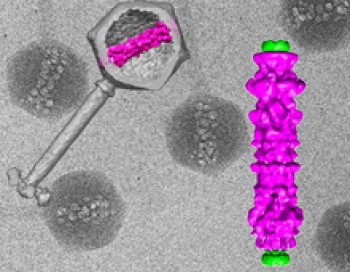Looking Inside Viruses
Looking Inside Viruses
Since the discovery of the microscope, scientists have tried to visualize smaller and smaller structures to provide insights into the inner workings of human cells, bacteria and viruses. Now, researchers have developed a new way to see tiny structures within viruses.
Conventional cryo-electron microscopy (cryo-EM) has allowed researchers to image the surface of viruses in great detail. But scientists hadn’t been able to clearly visualize structures inside viruses. Cryo-EM procedures use radiation, and higher doses damage viruses, destroying the very structures researchers would like to view.
A team led by Dr. Alasdair Steven of NIH’s National Institute of Arthritis and Musculoskeletal and Skin Diseases (NIAMS) and Dr. Lindsay Black at the University of Maryland Medical School was studying a type of virus that infects bacteria and so might one day be used to combat pathogens. Past studies showed that the virus, called ϕKZ, contains a cylindrical protein structure called the inner body. Those studies, however, used disrupted viruses. The inner body can’t be distinguished from the DNA that surrounds it in intact viruses using conventional cryo-EM.
In the January 13, 2012, issue of Science, the researchers described how they were able to turn the problem of radiation damage into an asset. They realized that the proteins inside the virus are more sensitive than DNA to radiation damage. After recording images of the virus with low doses of radiation, they used higher doses. As the inner structure deteriorated, it appeared as a cylinder of bubbles. The team was able to superimpose the images and, using 3-D computer reconstruction, clearly visualize the viral structure. The investigators call their technique bubblegram imaging.
Based on the shape and position of the inner body, the researchers believe that it helps organize DNA into its compact structure. In the future, bubblegram imaging may yield further insights into the inner workings of viruses and suggest strategies for developing novel therapies.
The scientists anticipate other uses for bubblegram imaging as well. For example, it could be used to visualize the interactions of proteins with DNA in human cells.
“This new cryo-EM procedure renders previously invisible proteins visible and, thus, will provide new understanding of cell biology,” Steven says.
###
* The above story is reprinted from materials provided by National Institutes of Health (NIH)
** The National Institutes of Health (NIH) , a part of the U.S. Department of Health and Human Services, is the nation’s medical research agency—making important discoveries that improve health and save lives. The National Institutes of Health is made up of 27 different components called Institutes and Centers. Each has its own specific research agenda. All but three of these components receive their funding directly from Congress, and administrate their own budgets.





















